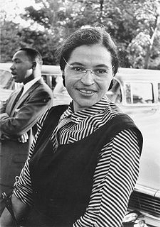In the popular imagination, Parks is seen as an old lady, but in fact she was forty-two at the time of her arrest.
replied to: cyclotreker
Replied to: In the popular imagination, Parks is seen as an old lady,...
The legend of Parks' stand against segregation would have one believe that the act of defiance was spontaneous when in fact it was planned in advance as part of a demonstration, the Montgomery Bus Boycott.
replied to: dbrunner
Replied to: The legend of Parks' stand against segregation would have one believe...
Not true. The boycott and MIA (Montgomery Improvement Association), which continued the boycott after the initial one day originally proposed (the following Monday four days later when Parks was tried), came about only after Parks was arrested, something Parks claims she did not plan on. Parks wasn't the first to defy this segregation law; the cases of four previous African-American women who had engaged in similar acts of civil disobedience were subsequently the basis for the civil rights suit that brought about an end to transportation segregation. After Parks arrest, M. L. King was chosen to head the MIA, where he got his start as a civil rights leader and gave his first civil rights speech (in response to her arrest).
E.D. Nixon asked Parks permission to conduct a boycott after bailing her out of jail. Some were prepared to boycott without her consent. Although Parks sat in the first seat reserved for blacks (in the middle of the bus), it is dubious she could have known in advance whether the bus would become crowded enough that particular day, causing the driver to ask her to stand for white passengers. Nor could she be certain she would be arrested, especially since she was technically legally within her rights under the law. Without an arrest, there would be insufficient popular support for a boycott. While Parks defiance was almost certainly spontaneous, in a sense it and the boycott were not. She had already worked for many years in the civil rights movement and was familiar with other cases involving bus segregation. Parks advised the NAACP Youth Council and member Claudette Colvin, who was one of the four women whose cases later formed the civil rights suit. The murder of 14-year old Emmet Till by white racists just four days previous to her arrest was also likely to have informed her decision. Moreover, the civil rights movement that so effectively mobilized a successful boycott did not spring up overnight in response to Parks predicament. Parks arrest may have been the spark that provided the impetus, but the growing opposition to Jim Crow laws, discrimination and segregation formed the basis for the boycott. However, there is no evidence indicating any collusion or conspiracy to deliberately use Parks to instigate the boycott.

